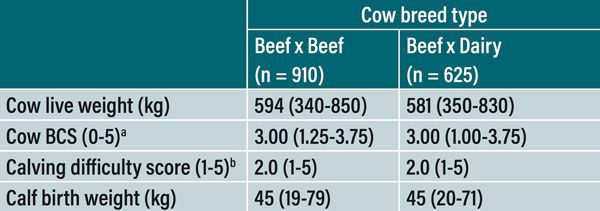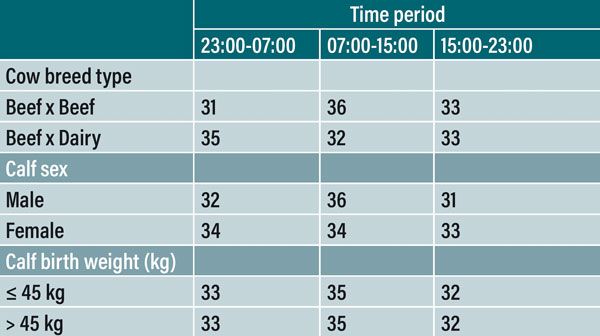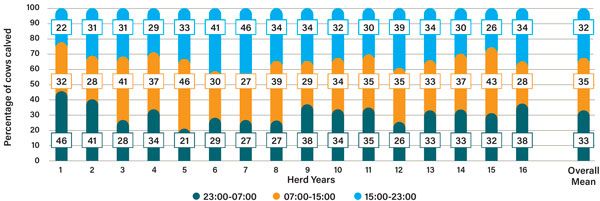Hourly distribution of time of calving in spring-calving suckler cows
A team of researchers from Teagasc and UCD have collaborated on a new study of hourly distribution of time of calving in spring-calving sucklers. The study was co-authored by Noeleen Brereton BSc, Mark McGee PhD, Colin Byrne PhD, Peter Doyle PhD, Bernadette Earley PhD, Teagasc, Grange Animal & Grassland Research and Innovation Centre, Dunsany, Co. Meath; David Meredith PhD, Teagasc, Rural Economy Development Programme, Ashtown, Dublin 15; and Marijke Beltman PhD, School of Veterinary Medicine, University College Dublin
*Corresponding author: bernadette.earley@teagasc.ie
Summary of study and findings
Time of calving was recorded for 1,535 calvings over 16 individual herd-years for suckler cows in spring-calving herds at Teagasc Grange. The cows were accommodated indoors each year and generally offered moderate dry matter digestibility grass silage ad libitum (straw included occasionally) with a mineral and vitamin supplement daily pre-partum. Time of daily feeding was usually in the morning. The cows were moved to individual straw-bedded calving pens pre-calving (approximately one to seven days). Calving times were expressed hourly over the ‘24-hour’ (h) day.
Mean hourly percentage of calvings ranged from 2.7 to 5.3, with large variation evident within hour. When categorised according to spring-time ‘daylight’ (08:00-16:00) and ‘darkness’ (16:00-08:00) hours, the mean hourly percentage of calvings was 4.1 and 4.4, respectively, corresponding to a distribution of 65 per cent and 35 per cent for those time periods. When the daily calving pattern was divided equally into three eight-hour periods; ‘night’ (23:00-07:00), ‘morning-day’ (07:00-15:00) and ‘evening-day’ (15:00-23:00), the mean distribution of calving times was 33, 35 and 32 per cent, respectively, albeit with large variation within each period (21-46, 27-46 and 22-46 per cent, respectively) across the herd-years. Cow breed type, calf sex, calf birth weight and calving difficulty did not appreciably influence the distribution of calving. It is concluded that, on average, the time of calving for spring-calving suckler cows was relatively evenly distributed throughout the 24-hour day, albeit large variation is evident across individual herd-years.
Introduction
Irish suckler beef production is principally based on seasonal spring-calving grass-based systems, with the calving season usually coinciding with the start of grass growth (McCabe et al, 2021). Calving principally occurs ‘indoors’ in Ireland (Todd et al, 2018), mainly from February to April (McGee et al, 2022).
Irish research indicates that livestock accounts for 65 per cent of all on-farm injuries, and that 35 per cent of fatal accidents are from attacks by ‘cow with calves’ (HSA, 2021). Working with calving cows, especially at night, can pose an increased safety risk to farmers. During the calving season, there is an increased demand on labour resources and, more often than not, the workload is confined to one individual on a suckler farm. Day and night time supervision is required for successful calvings, and to detect and manage dystocia problems should they arise (Dohmen et al, 2000), as well as any issues pertaining to colostrum ingestion and calf passive immunity (McGee and Earley, 2019).
To reduce the safety risks associated with calving, it would be preferable for the stock person to have cows calving during ‘normal’ working hours or during ‘daylight’ hours, when labour is more freely available, rather than during ‘night’ hours. Compared to dairy cows, there is relatively little research available characterising the diurnal and nocturnal calving pattern of suckler beef cows accommodated indoors, especially under Irish conditions. Consequently, the present study was undertaken to quantify the hourly distribution of time of calving during the ‘24-hour (h) day’ for beef × beef (B×B) and beef × dairy (B×D) suckler beef cows, taking into consideration cows requiring assistance at birth.
Materials and methods
Data were available from spring-herds calving at Teagasc, Grange between 1995 and 2023, resulting in 16 different herd-years. The dataset comprised beef × beef (n = 910) and beef × dairy (n = 625) cow breed types and included primiparous (first-calvers, n = 632; mean post-calving weight, 541kg) and multiparous (parity of ≥ 2, n = 903; mean post-calving weight, 624kg) animals. The beef breeds represented in the cows were Charolais (CH), Limousin (LM), Hereford (HE), Aberdeen Angus (AA), Belgian Blue (BB), Saler (SA) and Simmental (SI), and Holstein-Friesian (FR) in the dairy crossbreds. The cows were bred to Aberdeen Angus, Blonde d’Aquitaine, Belgian Blue, Charolais, Hereford, Limousin and Simmental sires.
The cows were accommodated indoors each year principally in slatted floor pens, and generally offered moderate-digestibility grass silage ad libitum, pre-partum. In occasional years, straw was included in the diet during the weeks immediately prior to calving. Time of daily feeding was usually in the morning. Cows had free access to water and received a mineral and vitamin supplement daily. Prior to parturition (approximately one to seven days), the cows were moved to individual straw-bedded calving pens. Assistance at calving was recorded: 1 = no assistance; 2 = minor handling (‘checking’); 3 = minor assistance; 4 = mechanical assistance (calving jack) and 5 = caesarean section. For the purposes of presentation of results, calving difficulty was divided into two categories namely, ‘unassisted’ (score 1 and 2 combined) and ‘assisted’ (score 3 to 5 combined). Cows with multiple births (twins) were omitted from the study. Calving times were expressed hourly over the ’24-hour-day’. A further categorisation representing spring-time ‘daylight’ (08:00-16:00) and ‘darkness’ (16:00-08:00) hours, was evaluated. The daily calving pattern during each ‘24-hour-day’ was divided equally into three eight-hour periods defined as: ‘night’ (23:00-07:00), ‘morning-day’ (07:00-15:00) and ‘evening-day’ (15:00-23:00).

a BCS = body condition score, ranges from 0 (emaciated) to 5 (obese) (Lowman et al., 1976).
b Calving difficulty is scored from 1 to 5 (1 = no assistance; 2 = minor handling (‘checking’); 3 = minor assistance; 4 = mechanical assistance (calving jack); and 5 = caesarean section).
Table 1: Mean (min and max) post-calving cow live weight, body condition score (BCS), calving difficulty score and calf birth weight.
Results
The mean cow live weight and body condition score post-partum, calving difficulty score and calf birth weight across the 16 herd-years are shown in Table 1.
Daily distribution of calvings
The hourly distribution of calving over the 16 herd-years is presented in Figure 1. The mean hourly calving pattern over 24 hours ranged from 2.7 per cent at 17:00 h to 5.3 per cent at 14:00h, with large variation evident within each hour across the herd-years (Figure 1). When the 24-h day was divided into ‘darkness’ (16:00-08:00 – 16 hours) and “daylight” (08:00-16:00 – eight hours) the mean hourly percentage of calvings was 4.1 and 4.4, respectively, corresponding to a distribution of 65 per cent and 35 per cent for those time periods (Figure 1).
When the 24-hour day was divided equally into three eight-hour periods representing ‘night’ (23:00-07:00), ‘morning-day’ (07:00-15:00) and ‘evening-day’ (15:00-23:00), the mean percentage of calvings ranged from 21-46 per cent, 27-46 per cent and 22-46 per cent, respectively, across the 16 herd-years (Figure 2). The overall mean percentage of calvings for the 16 herd-years distributed in the three eight-hour periods was 33, 35 and 32 per cent, respectively (Figure 2).

Figure 1: The hourly distribution (mean percentage with SD, indicated by the bars) of calvings throughout the ’24-hour’ day for the 16 herd-years (orange bars, 08:00-16:00 = ‘daylight’ and blue bars, 16:00-08:00 = ‘darkness’).
Calving distribution according to cow breed type and calf sex
The distribution of calvings in the three 8-h periods (23:00-07:00, 07:00-15:00 and 15:00-23:00h) for Beef × Beef and Beef × Dairy cow breed types, male and female calves and ‘light’ and ‘heavy’ calves is shown in Table 2. Cow breed type, calf sex and calf birth weight classification were relatively evenly distributed over the three 8-h blocks.

Table 2: Distribution of calvings ( per cent ) in three 8-h periods (‘night’, 23:00-07:00; ‘morning-day’, 07:00-15:00; ‘evening-day’, 15:00-23:00) according to cow breed type, calf sex and calf birth weight.
Calving distribution according to calving difficulty
The distribution of calvings in the three 8-h periods (23:00-07:00, 07:00-15:00, and 15:00-23:00 h) according to the calving difficulty classification was relatively evenly distributed (Figure 3).
Discussion
The present study examined the diurnal and nocturnal pattern and frequency of calvings over 16 herd-years in spring-calving suckler beef cows. The relatively uniform hourly distribution of calvings over 24 hours in the present study is in agreement with Yarney et al (1982) who reported a range of 3.1 per cent to 5.2 per cent for beef cows.
In the present study, when the 24-h period was divided into three 8-h blocks, the calving distribution was relatively evenly distributed. This concurs with Yarney et al (1982) who found an even distribution (51.5 and 48.5 per cent ) in beef cow calvings when the 24-h period was divided into two 12-h blocks (07:00-19:00 and 19:00–07:00). Similarly, Makarechian (1984) found a calving distribution of 54.4 and 45.6 per cent in beef cows when the 24-h period was divided into two blocks (06:30 – 19:00 and 19:00 – 06:30); these frequencies did not deviate significantly from the expected frequency of 50 per cent. Likewise, Jaeger et al (2008) found that nearly equal proportions (52.1 v. 47.9 per cent) of spring-calving Hereford and Charolais cows gave birth during daylight hours (06:00-18:00) and night-time hours (18:00-06:00). Furthermore, when the 24-h day was divided into six 4-h blocks the distribution of all observed calvings (16.8, 20.1, 21.9, 16.8, 8.6 and 15.2 per cent) was nearly equal. In a study with spring-calving dairy cows, Edwards (1979) reported that calvings were evenly distributed throughout the 24 hours, with no bias towards day or night.

Figure 2: Distribution of calvings in three eight-hour periods (‘night’, 23:00-07:00; ‘morning-day’, 07:00-15:00; ‘evening-day’, 15:00-23:00) for each of the 16 individual herd-years and the overall mean eight-hour distribution.
In the current study, there was an even distribution of calvings over the three 8-h blocks according to cow breed type, calf sex and calf birth weight. Yarney et al (1982), found no effect of calf sex or calf birth weight on calving distribution in beef cows when the ‘24-h day’ was divided into six 4-h periods. However, in that study when the effect of cow breed was investigated, an uneven distribution of calvings was found; for example, Hereford and Angus cows were more likely to calve during the day, while Shorthorn cows would more likely calve at night.
In the present study, the distribution of assisted calvings in the three 8-h periods (24, 24 and 28 per cent) was relatively uniformly distributed. In contrast, Yarney et al (1982) found an uneven distribution of dystocic calvings in beef cows over six 4-h blocks with the greatest incidence occurring from 11:00-15:00 (22.2 per cent ) and the lowest from 23:00-03:00 (12.1 per cent). Distribution of assisted calvings may be a reflection of the presence of a stockperson; usually, there is a smaller staff presence at night to offer assistance at birth.
Commercially, there is a lot of interest in reducing the incidence of ‘night-time’ calving and, in this regard a number of studies have investigated the effect of time of feeding on parturition. Lowman et al (1981) examined the time of feeding of suckler beef cows on commercial farms, when the 24-hour day was divided into 16 hours of daylight (06:00 to 22:00) and 8 hours of darkness (22:00 to 06:00). On the two individual farms with a ‘control’ group of animals, there was no statistical significance between morning- and evening-fed cows calving in the night. In contrast, Yarney et al. (1979) reported less calvings during the day (38 per cent) in beef cows than at night (62 per cent) when animals were fed at 08:00-09:00h and at 15:00-16:00h; conversely, cows fed at 11:00-12:00 and 21:00-22:00 calved more during the day (80 per cent). In dairy cows, a study by Pennington and Albright (1985), which examined the effect of feeding on time of parturition when the ‘24-hour day’ was divided into two 12-hour blocks, found that time of feeding had no effect on time of calving with 62.5 per cent of control cows calved from 06:00 to 18:00h compared with 67.7 per cent of night-fed animals. Similarly, MacMillan et al (1985) reported that altering the feeding time from 07:00 to either 16:00 or 19:00h did not increase the frequency of daylight calvings in dairy cows. A pilot study by Gleeson et al (2003) found that restricting silage feeding time to between 20:30 and 10:30h resulted in nine per cent less calvings compared to cows with full access to silage, whereas an even distribution of calvings occurred when cows had continuous access to silage. A further study by Gleeson et al (2007) found that restricting access to silage resulted in less calvings at night (00:30-06:29) compared to cows with ad libitum access to silage (18 v. 22 per cent). Furthermore, the percentage of calvings at night was lower (13 per cent) when access to silage was restricted for 10h compared to 2, 4 or 6h (22, 18, and 25 per cent, respectively). However, although offering silage to pregnant Holstein-Friesian cows in the evening, after a period of restricted access, reduced the incidence of night-time calvings, it increased the incidence of dystocia and stillbirth. Collectively, these findings suggest that time of feeding does not always alter the time of parturition and, where it does, the impact is often relatively modest. More research is required in this area for suckler beef cows.
Conclusion
Under the conditions of this study, it is concluded that, on average, time of calving for spring-calving suckler cows is relatively evenly distributed throughout the 24-hour day, albeit large variation is evident across individual herd-years. Cow breed type, calf sex and calf birth weight did not obviously influence the distribution of calving. The distribution of unassisted and assisted calvings were equally distributed. The distribution of calving times in the current study implies that approximately one third of suckler cows calve during unsociable hours (i.e., night-time) when labour is less freely available. Working alone with calving cows, especially at night, may pose an increased safety risk to farmers.

Figure 3: Distribution of calvings in three 8-hour periods (‘night’, 23:00-07:00; ‘morning-day’, 07:00-15:00, ‘evening-day’, 15:00-23:00) according to calving difficulty classification. Calving difficulty score (1-5) was categorised as either ‘unassisted’ (score 1-2) or ‘assisted’ (score 3-5).
References
Dohmen, M. J. W., Joop, K., Sturk, A., Bols, P. E. J. & Lohuis, J. A. C. M. Relationship between intra-uterine bacterial contamination, endotoxin levels and the development of endometritis in postpartum cows with dystocia orretained placenta. Theriogenol. 2000; 54: 1019-1032.
Edwards, S. A. The timing of parturition in dairy cattle. J. Agric. Sci.1979; 93:
359-363. Gleeson, D., O Brien, B., O Donovan, K., Mee, J. Effect of silage feeding regimen on time of calving and behavior in Holstein-Friesian cows. J. Appl. Res. Vet. Med. 2003; 1: 311-317.
Gleeson, D. E., O’Brien, B., Mee, J. F. Effect of restricting silage feeding prepartum on time of calving, dystocia and stillbirth in Holstein-Friesian cows. Irish Vet. J.2007; 60: 667-671.
HSA. 2021. Livestock Fatalities [Online]. HSA. Available: https://www.hsa.ie eng/Your_Industry/Agriculture_Forestry/Livestock/#preTeagasc [Accessed 08/01/2024].
Jaeger, J. R., Olson, K. C., DelCurto, T. & Qu, A. Pattern of Parturition as Affected by Time of Feeding and Prediction of the Time of Day that Parturition Will Occur in Spring-Calving Beef Cows. Prof. Anim. Sci. 2008; 24; 247-253.
Lowman, B., Scott, N. A. & Somerville, S. 1976. Condition scoring beef cattle. Edinburgh: East of Scotland College of Agriculture, 8.
Lowman, B. G., Hankey, M. S., Scott, N. A., Deas, D. W. & Hunter, E. A. 1981. Influence of time of feeding on time of parturition in beef cows. Vet. Rec. 1981; 109: 557-559.
MacMillan, K. L., Pearce, M. G., Copeman, P. J. A., MacDonald, K. A., Kilgour, R. Effects of varying feeding time on diurnal calving patterns in dairy cows. Proc. New Zealand Soc. Anim. Prod. 1985; 45: 35-38.
Makarechian, M. Factors Influencing Time of Parturition in Range Beef Cattle. Can. Vet. J. 1984; 12; 450-452.
McCabe, S., McHugh, N., O’Connell, N. E., Prendiville, R. Performance of lactating suckler cows of diverse genetic merit and genotype under a seasonal pasture-based system. Irish J of Agric. Food Res. 2021; 60: 91-101.
McGee, M., Earley, B. Review: passive immunity in beef-suckler calves. Animal. 2019; 13: 810-825.
McGee, M., Harrington, M., Byrne, N., Crosson, P. Performance targets for resilient beef production In: TEAGASC (ed.) BEEF 2022 Supporting Sustainable Beef Farming. 2022; p24-29. ISBN: 978-1-84170-678-8.
Pennington, J. A. & Albright, J. L.,. Effect of Feeding Time, Behavior, and Environmental Factors on the Time of Calving in Dairy Cattle. Journal of Dairy Science, 68, 2746-2750.
Todd, C. G., McGee, M., Tiernan, K., Crosson, P., O’Riordan, E., McClure, J., Lorenz, I., Earley, B. An observational study on passive immunity in Irish suckler beef and dairy calves: Tests for failure of passive transfer of immunity and associations with health and performance. Prev. Vet. Med. 2018; 159: 182-195.
Yarney, T. A., Rahnefeld, G. W., Konefal, G., Boston, A. C., MeCannel, B., Sigurdson, M., Parker, R. J., Palmer, W. M. Time of day of parturition in beef cows. Can. J. Anim. Sci. 1979;59(Abstr):836
Yarney, T. A., Parker, R. J., Palmer, W. M., Rahnefeld, G. W. 1982. Hourly distribution of time of parturition in beef cows Can. J. Anim. Sci. 1982; 62: 597-605.
1. In relation to distribution of suckler cow calvings, which is correct?
A. A greater percentage of cows calve during daylight hours
B. The calving distribution is evenly distributed throughout the 24-hour day
C. Calf breed influences time of calving
D. Calf sex influences time of calving
2. When the daily calving pattern was divided equally into three eight-hour periods –‘night’ (23:00-07:00), ‘morning-day’ (07:00-15:00) and ‘evening-day’ (15:00-23:00) – the mean distribution of calving times was?
A. 55 per cent 22 per cent 23 per cent
B. 33 per cent 35 per cent 32 per cent
C. 25 per cent 22 per cent 53 per cent
D. 80 per cent 10 per cent 10 per cent
3. The distribution of calvings in the three 8-hour periods (23:00-07:00, 07:00-15:00, and 15:00-23:00) according to the calving difficulty classification was:
A. Greatest from 23:00-07:00
B. Greatest from 07:00-1500
C. Greatest from 15:00-23:00
D. Evenly distributed
4. Day and night time supervision is required for:
A. Successful calvings
B. Detection and management of dystocia problems should they arise
C. Effective addressing of any issues pertaining to colostrum ingestion and calf passive immunity
D. All of the above
5. Findings suggest that time of feeding does not always alter the time of parturition and, where it does, the impact is?
A. Modest
B. Dependent on cow breed?
C. Dependent on type of diet fed?
D. None of the above?
ANSWERS: 1B; 2B; 3D; 4D; 5A.









